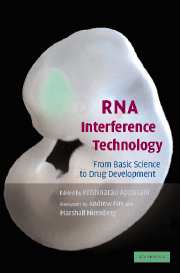Book contents
- Frontmatter
- Contents
- Foreword by Andrew Fire
- Foreword by Marshall Nirenberg
- List of Contributors
- Introduction
- Section one Basic RNAi, siRNA, microRNAs and gene-silencing mechanisms
- Section two Design, synthesis of siRNAs
- Section three Vector development and in vivo, in vitro and in ovo delivery methods
- 10 Six methods of inducing RNAi in mammalian cells
- 11 Viral delivery of shRNA
- 12 siRNA delivery by lentiviral vectors: Design and applications
- 13 Liposomal delivery of siRNAs in mice
- 14 Chemical modifications to achieve increased stability and sensitive detection of siRNA
- 15 RNA interference in postimplantation mouse embryos
- 16 In ovo RNAi opens new possibilities for functional genomics in vertebrates
- Section four Gene silencing in model organisms
- Section five Drug target validation
- Section six Therapeutic and drug development
- Section seven High-throughput genome-wide RNAi analysis
- Index
- Plate section
- References
14 - Chemical modifications to achieve increased stability and sensitive detection of siRNA
Published online by Cambridge University Press: 31 July 2009
- Frontmatter
- Contents
- Foreword by Andrew Fire
- Foreword by Marshall Nirenberg
- List of Contributors
- Introduction
- Section one Basic RNAi, siRNA, microRNAs and gene-silencing mechanisms
- Section two Design, synthesis of siRNAs
- Section three Vector development and in vivo, in vitro and in ovo delivery methods
- 10 Six methods of inducing RNAi in mammalian cells
- 11 Viral delivery of shRNA
- 12 siRNA delivery by lentiviral vectors: Design and applications
- 13 Liposomal delivery of siRNAs in mice
- 14 Chemical modifications to achieve increased stability and sensitive detection of siRNA
- 15 RNA interference in postimplantation mouse embryos
- 16 In ovo RNAi opens new possibilities for functional genomics in vertebrates
- Section four Gene silencing in model organisms
- Section five Drug target validation
- Section six Therapeutic and drug development
- Section seven High-throughput genome-wide RNAi analysis
- Index
- Plate section
- References
Summary
Introduction
RNA interference (RNAi) was discovered in the worm C. elegans as an endogenous, double-stranded RNA (dsRNA) driven mechanism resulting in a specific inhibition of gene expression on a posttranscriptional level (Fire et al., 1998). Since then, gene suppression by RNA interference has been widely applied to study gene function in a variety of organisms (Hannon, 2002). Double-stranded small interfering RNA (siRNA) of 21 to 23 nucleotides was identified as mediator of this silencing signal in a Drosophila embryo lysate system (Elbashir et al., 2001b). In a seminal study it was demonstrated that exogenously delivered chemically synthesized siRNA can function as trigger for this specific silencing mechanism in mammalian cells (Elbashir et al., 2001a). Initial experiments indicated that, in contrast to long dsRNA, siRNA does not stimulate an unspecific inhibition of protein synthesis mediated by activation of protein kinase R (PKR) in mammals (Caplen et al., 2001). Because of its specificity and high efficiency as well as simple practicability, siRNA triggered RNAi has become rapidly accepted as the method of choice for studying gene function in cell culture systems. Moreover, recent reports demonstrated the successful siRNA-mediated down-regulation of reporter genes (McCaffrey et al., 2002; Lewis et al., 2002) as well as endogenous target genes in mice (Xia et al., 2002; Song et al., 2003; Rubinson et al., 2003). Now, researchers in academia and industry are attempting to utilize RNAi as a platform for the development of therapeutics.
- Type
- Chapter
- Information
- RNA Interference TechnologyFrom Basic Science to Drug Development, pp. 194 - 206Publisher: Cambridge University PressPrint publication year: 2005



